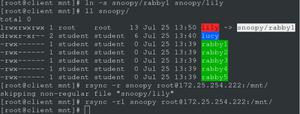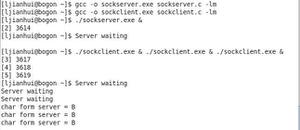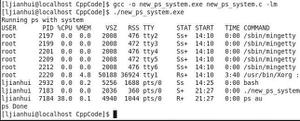Linux 3.0:使用管道标准输入/标准输出执行子进程
在Linux 3.0 / C ++下:
我想要一个执行以下操作的函数:
string f(string s){
string r = system("foo < s");
return r;
}
显然上述方法不起作用,但是您可以理解。我有一个字符串s,我希望将其作为应用程序“
foo”的子进程执行的标准输入传递,然后将其标准输出记录到字符串r中,然后将其返回。
我应该使用linux syscall或posix函数的什么组合?
回答:
eerpini提供的代码无法正常工作。请注意,例如,之后将使用在父级中关闭的管端。看着
close(wpipefd[1]);以及随后对该封闭描述符的写入。这只是换位,但它表明此代码从未使用过。以下是我测试过的版本。不幸的是,我更改了代码样式,因此这不接受作为eerpini代码的编辑。
唯一的结构更改是,我仅重定向子级中的I / O(请注意dup2调用仅在子级路径中。)这非常重要,因为否则父级的I /
O会混乱。感谢eerpini提出的最初答案,我在开发此答案时使用了它。
#include <stdio.h>#include <stdlib.h>
#include <unistd.h>
#include <errno.h>
#define PIPE_READ 0
#define PIPE_WRITE 1
int createChild(const char* szCommand, char* const aArguments[], char* const aEnvironment[], const char* szMessage) {
int aStdinPipe[2];
int aStdoutPipe[2];
int nChild;
char nChar;
int nResult;
if (pipe(aStdinPipe) < 0) {
perror("allocating pipe for child input redirect");
return -1;
}
if (pipe(aStdoutPipe) < 0) {
close(aStdinPipe[PIPE_READ]);
close(aStdinPipe[PIPE_WRITE]);
perror("allocating pipe for child output redirect");
return -1;
}
nChild = fork();
if (0 == nChild) {
// child continues here
// redirect stdin
if (dup2(aStdinPipe[PIPE_READ], STDIN_FILENO) == -1) {
exit(errno);
}
// redirect stdout
if (dup2(aStdoutPipe[PIPE_WRITE], STDOUT_FILENO) == -1) {
exit(errno);
}
// redirect stderr
if (dup2(aStdoutPipe[PIPE_WRITE], STDERR_FILENO) == -1) {
exit(errno);
}
// all these are for use by parent only
close(aStdinPipe[PIPE_READ]);
close(aStdinPipe[PIPE_WRITE]);
close(aStdoutPipe[PIPE_READ]);
close(aStdoutPipe[PIPE_WRITE]);
// run child process image
// replace this with any exec* function find easier to use ("man exec")
nResult = execve(szCommand, aArguments, aEnvironment);
// if we get here at all, an error occurred, but we are in the child
// process, so just exit
exit(nResult);
} else if (nChild > 0) {
// parent continues here
// close unused file descriptors, these are for child only
close(aStdinPipe[PIPE_READ]);
close(aStdoutPipe[PIPE_WRITE]);
// Include error check here
if (NULL != szMessage) {
write(aStdinPipe[PIPE_WRITE], szMessage, strlen(szMessage));
}
// Just a char by char read here, you can change it accordingly
while (read(aStdoutPipe[PIPE_READ], &nChar, 1) == 1) {
write(STDOUT_FILENO, &nChar, 1);
}
// done with these in this example program, you would normally keep these
// open of course as long as you want to talk to the child
close(aStdinPipe[PIPE_WRITE]);
close(aStdoutPipe[PIPE_READ]);
} else {
// failed to create child
close(aStdinPipe[PIPE_READ]);
close(aStdinPipe[PIPE_WRITE]);
close(aStdoutPipe[PIPE_READ]);
close(aStdoutPipe[PIPE_WRITE]);
}
return nChild;
}
以上是 Linux 3.0:使用管道标准输入/标准输出执行子进程 的全部内容, 来源链接: utcz.com/qa/413696.html









